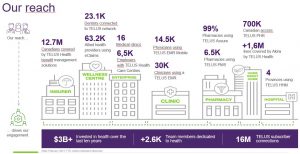
CCO Tony Geheran on growth opportunities and funding broadband better
By Greg O’Brien
IN THE CANADIAN TELECOM world, the two big eastern Canada-based companies get a lot of the attention from those of us in the press.
And they should. They’re dominant in wireless and broadband and pay-TV in the most populous two provinces in Canada. They also own sports teams and television and radio stations and digital outlets. Their names are on the arenas in which some of our most beloved pro teams play. They’re in the media and they are the media. We can’t help ourselves.
Which means Telus, big as it is as a member of the so-called Big Three, seems to sometimes fly under the radar, especially for many in the eastern half of Canada.
And it shouldn’t. But the fact it does, rankles its leaders a little.
Telus International just went public with an initial valuation of $8.5 billion. Telus Health and Telus Agriculture are both growing rapidly and are headed for their own initial public offerings at some point in the future. The company works hard to set itself apart as a stalwart in what it calls “social capitalism”, thanks in no small part to those growing divisions aimed at improving the world’s food chain and overall health.
However, while the company has garnered some recent headlines, much press and consumer and investor attention is often dragged off by the challenges of the media businesses of its peers and away from Telus’s tech-driven growth.
“We’ve been on a divergent strategy from our competition locally for about 15 years now,” said Telus executive vice-president and chief customer officer Tony Geheran (above) in an interview with Cartt.ca the day the company released its Q4 results.
“We didn’t see the value of media ownership or content ownership. We saw the value in the aggregation of that and bringing the best content to our customers… But outside of that, we saw TV viewership is shrinking, certainly on a managed broadcast basis. Those traditional models are under threat,” he added.
“We’re not really into ego plays like sports, and sports sponsorship. We don’t really see how that drives business value – but what we are interested in is finding areas of growth where our competition isn’t, and health and ag tech are places where none of our traditional competitors are playing – where we can leverage the full strength of our technology and our networks to apply a level of thought leadership in terms of how you can bring that technology to bear, to drive great social change.”
Both agriculture and health are serious growth opportunities being embraced around the world by Telus and many others and these lines of business are not bound by our borders, unlike our regulated, protected, telecom and TV systems, so growth could be exponential.
Right now, 12.7 million Canadians are covered by some form of Telus Health management solutions, 63,000 health providers use its eClaims, 30,000 clinicians use its electronic medical records system, and 2,600 Telus employees are dedicated to Telus Health. The company has invested over $3 billion in health over the past 10 years.
On the agriculture side, the company says its solutions already support more than 100 million acres of land in Canada, the U.S., U.K., Mexico, Brazil, Germany, Australia, China, Slovakia, and Armenia with 1,200 team members.
“When you look at the size of the global market just for health, budgets even in Canada dwarf the telecom opportunity spend.” – Tony Geheran, Telus
“When you look at the size of the global market just for health, budgets even in Canada dwarf the telecom opportunity spend. And if you look at it globally, it’s phenomenal, so we have been somewhat perplexed that strategic divergence hasn’t been more picked up,” said Geheran of the relative lack of attention Telus receives.
That said though, the success of Telus International has only emboldened the company.

Telus Health’s current reach in Canada. Slide provided by Telus.
“The IPO of Telus international has woken some analysts and people up, but when you see people scrambling over a reducing set of eyeballs for (TV), how does that warrant any media time when you’ve got a planet to feed or, or you’ve got an aging demographic that needs better health care… and you’ve got a pandemic ongoing? Having health assets that can deliver telemedicine, that can deliver secure data across efficient broadband networks, to me is what people should be interested in,” added Geheran.
“So, I’m expecting this year, we would start to see people wake up to the fact that we are doing something different.”
Make no mistake either, Telus plans to replicate the success it has so far enjoyed with Telus International and use it as a blueprint for health and agriculture. “You can draw inference from what’s transpired at TI in terms of what it portends for our emerging growth businesses,” CEO Darren Entwistle said about the company’s agriculture and health divisions during the company’s fourth quarter conference call with analysts on February 11th.
“Using the blueprint etched by Telus International (TI), we expect a similar nurturing and cultivation process with emergent TH and TAG businesses as they grow to scale through a combination of organic growth and strategic M&A,” wrote BMO Capital Markets telecom analyst Tim Casey in a report to investors after the company’s annual results were released. “Telus’s TH and TAG businesses are differentiated and well situated to capitalize on 5G with clear synergies in terms of the digital infrastructure needed for these groups through Telus’s broadband technology.”
“It’s about value creation centered around profitable scale to build tremendous assets of consequence within those businesses, and that’s what we’re setting out to do with a very specific game plan in that regard,” continued Entwistle during the call. “The other thing that is more and more clear to people is this synergistic nature of Telus Corporation’s focus on technology and data centric, digital strategies that are getting imparted to our emerging growth assets… It’s all about our digital progression.”
“Telcos have historically been experts in building network platforms (historically closed hardware platforms) that scale,” added Scotiabank telecom analyst Jeff Fan in a note to investors after the Q4 release, and who rates Telus the same as Casey as ‘sector outperform’. “CEO Darren Entwistle’s vision here reflects a shift to a more software-led platform where 5G applications as well as other vertical apps in TH and TA can sit on.”
All this global growth, however, doesn’t mean the company is taking its eye off the ball in Canada. It continues to focus on 5G (because the new wireless tech looks to drive serious future enterprise gains, especially in health and agriculture), and growing its PureFibre footprint out west and in Quebec. Geheran said the company would also love to build into more rural areas, too, if only the government funders would get their acts together.
“Certain political individuals and parties are keener on making announcements than actually achieving outcomes.” – Geheran
“I’ve long been… a bit of an outspoken critic of the way the federal funding and provincial funding mechanisms have worked,” he said. “Certain political individuals and parties are keener on making announcements than actually achieving outcomes, and we have squandered many years talking about investment funds that will support rural connectivity without deploying the capital efficiently.
“We went to ISED, Industry Canada before that, and the CRTC and we said ‘look, we can tell you how to build this stuff. We will share every piece of data we’ve got because we’ve been building in small towns so we know what it’s like to go to small, rural or remote areas. It’s not easy, but you can do it’. If you’re very focused and you have specific, set objectives around getting customers connected – not getting a point of presence in a community and saying you deliver broadband – getting actual broadband into the homes, to the devices of the end user, that is what drives transformation that drives digital connectivity.”
Telus has built partnerships with some Indigenous communities and wants to bring broadband to as many rural regions as possible, including where it can tap into federal or provincial funding for regions where it doesn’t make economic sense to build a network, said Geheran. “But the challenge has been a provincial timeline and a federal timeline and a funding mechanism where the two things don’t line up where they should.
“Any government money should be put together to drive the best outcome for the constituents and the taxpayers – and if you’re going to leverage private money as well, you want to make sure that there are hard outcomes that are documented so you can measure the success and the efficacy of the investment,” he continued.
“We’ve committed to going open-book. We’ve committed to showing how we would build and plan, the targets we would commit to, the timelines we’d commit to, and the proof points – which would be end users having access to the best broadband – as measures of success. We’re starting to see a shift from the government. Only this last year we’re starting to see a bit more of the funding flowing and a bit more of the programs coming together.”
Governments actually building networks though, is a bridge too far for Geheran. The city of Toronto just decided to see if it can push into the consumer broadband market to try and make it more affordable for low income Torontonians, but Geheran believes that will prove to be a waste of resources.
“Everyone thinks they can build a network. And I’m really saddened that the city of Toronto is going to go down that path. First of all, Toronto doesn’t have the problem it thinks it has. It has poor people who don’t have access to technology, and that’s a problem that needs to be solved,” he said, adding it won’t be solved through the laying or stringing of more fibre. “Generally there’s a lot of broadband available in the city of Toronto,” he added.
(It’s also worth noting Telus offers subsidized broadband programs for low-income Canadians, as do Rogers, Bell and others.)
“That will be public money, squandered and wasted. Municipalities which go into trying to build a network don’t realize you have to sustain that environment. You have to do technology refresh, you have to attract resources that can support and build that network and maintain it efficiently.
“Then you have to look at what is the plan for leveraging that network to layer incremental services upon it so it’s a growing network infrastructure that creates value rather than a stagnant one – and I’ve never seen a successful municipality scheme that has gone beyond five to 10 years where the municipality isn’t regretting the steps they took, isn’t trying to sell the assets to a network operator. And I fear that city of Toronto will go down the same path.”



